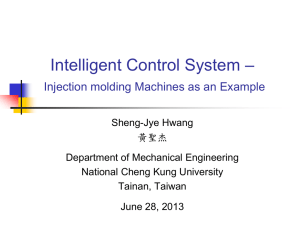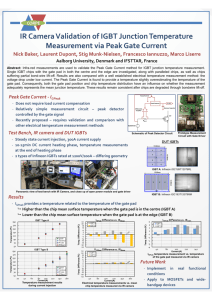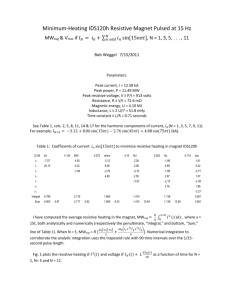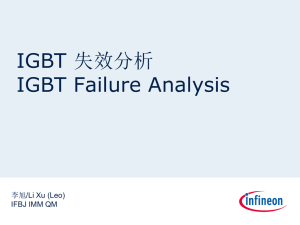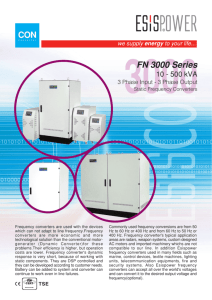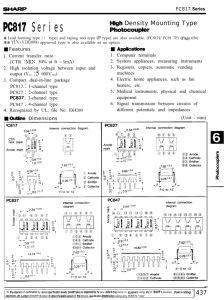Insulated Gate Bipolar Transistor (IGBT) Basics
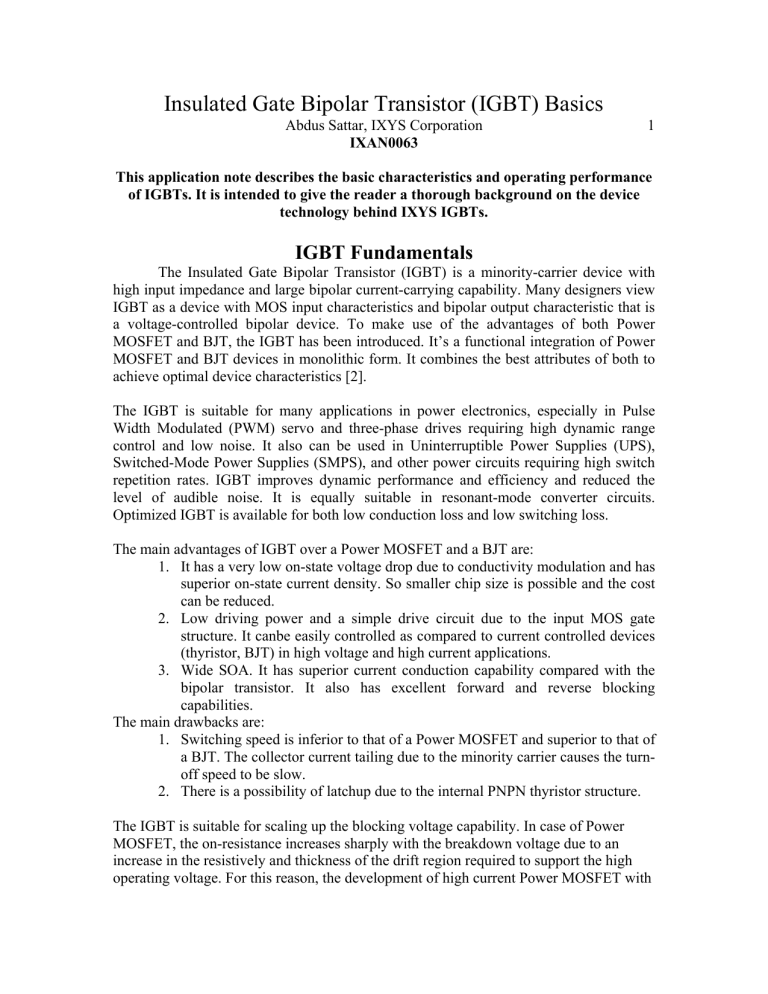
Insulated Gate Bipolar Transistor (IGBT) Basics
Abdus Sattar, IXYS Corporation 1
IXAN0063
This application note describes the basic characteristics and operating performance of IGBTs. It is intended to give the reader a thorough background on the device technology behind IXYS IGBTs.
IGBT Fundamentals
The Insulated Gate Bipolar Transistor (IGBT) is a minority-carrier device with high input impedance and large bipolar current-carrying capability. Many designers view
IGBT as a device with MOS input characteristics and bipolar output characteristic that is a voltage-controlled bipolar device. To make use of the advantages of both Power
MOSFET and BJT, the IGBT has been introduced. It’s a functional integration of Power
MOSFET and BJT devices in monolithic form. It combines the best attributes of both to achieve optimal device characteristics [2].
The IGBT is suitable for many applications in power electronics, especially in Pulse
Width Modulated (PWM) servo and three-phase drives requiring high dynamic range control and low noise. It also can be used in Uninterruptible Power Supplies (UPS),
Switched-Mode Power Supplies (SMPS), and other power circuits requiring high switch repetition rates. IGBT improves dynamic performance and efficiency and reduced the level of audible noise. It is equally suitable in resonant-mode converter circuits.
Optimized IGBT is available for both low conduction loss and low switching loss.
The main advantages of IGBT over a Power MOSFET and a BJT are:
1.
It has a very low on-state voltage drop due to conductivity modulation and has superior on-state current density. So smaller chip size is possible and the cost can be reduced.
2.
Low driving power and a simple drive circuit due to the input MOS gate structure. It canbe easily controlled as compared to current controlled devices
(thyristor, BJT) in high voltage and high current applications.
3.
Wide SOA. It has superior current conduction capability compared with the bipolar transistor. It also has excellent forward and reverse blocking capabilities.
The main drawbacks are:
1.
Switching speed is inferior to that of a Power MOSFET and superior to that of a BJT. The collector current tailing due to the minority carrier causes the turnoff speed to be slow.
2.
There is a possibility of latchup due to the internal PNPN thyristor structure.
The IGBT is suitable for scaling up the blocking voltage capability. In case of Power
MOSFET, the on-resistance increases sharply with the breakdown voltage due to an increase in the resistively and thickness of the drift region required to support the high operating voltage. For this reason, the development of high current Power MOSFET with
Insulated Gate Bipolar Transistor (IGBT) Basics
Abdus Sattar, IXYS Corporation
IXAN0063 high-blocking voltage rating is normally avoided. In contrast, for the IGBT, the drift region resistance is drastically reduced by the high concentration of injected minority carriers during on-state current conduction. The forward drop from the drift region becomes dependent upon its thickness and independent of its original resistivity.
2
Basic Structure
The basic schematic of a typical N-channel IGBT based upon the DMOS process is shown in Figure 1. This is one of several structures possible for this device.
It is evident that the silicon cross-section of an IGBT is almost identical to that of a vertical
Power MOSFET except for the P and P wells with N
+
+
injecting layer. It shares similar MOS gate structure
source regions. The N
+
layer at the top is the source or emitter and the P
+
layer at the bottom is the drain or collector. It is also feasible to make P-channel
IGBTs and for which the doping profile in each layer will be reversed. IGBT has a parasitic thyristor comprising the four-layer NPNP structure. Turn-on of this thyristor is undesirable.
Figure 1 : Schematic view of a generic N-channel IGBT [2]
Some IGBTs, manufactured without the N
+
buffer layer, are called non-punch through
(NPT) IGBTs whereas those with this layer are called punch-through (PT) IGBTs. The presence of this buffer layer can significantly improve the performance of the device if the doping level and thickness of this layer are chosen appropriately. Despite physical similarities, the operation of an IGBT is closer to that of a power BJT than a power
MOSFET. It is due to the P
+ drain layer (injecting layer) which is responsible for the minority carrier injection into the N
-
-drift region and the resulting conductivity modulation.
Insulated Gate Bipolar Transistor (IGBT) Basics
Abdus Sattar, IXYS Corporation
IXAN0063
3
Figure 2 : Equivalent circuit model of an IGBT [2]
Based on the structure, a simple equivalent circuit model of an IGBT can be drawn as shown in Figure 2.
It contains MOSFET, JFET, NPN and PNP transistors. The collector of the PNP is connected to the base of the NPN and the collector of the NPN is connected to the base of the PNP through the JFET. The NPN and PNP transistors represent the parasitic thyristor which constitutes a regenerative feedback loop. The resistor R
B represents the shorting of the base-emitter of the NPN transistor to ensure that the thyristor does not latch up, which will lead to the IGBT latchup. The JFET represents the constriction of current between any two neighboring IGBT cells. It supports most of the voltage and allows the MOSFET to be a low voltage type and consequently have a low
R
DS(on)
value. A circuit symbol for the IGBT is shown in Figure 3. It has three terminals called Collector (C), Gate (G) and Emitter (E).
Figure 3 : IGBT Circuit Symbol
IXYS has developed both NPT and PT IGBTs. The physical constructions for both of them are shown in Figure 4. As mentioned earlier, the PT structure has an extra buffer layer which performs two main functions: (i) avoids failure by punch-through action because the depletion region expansion at applied high voltage is restricted by this layer,
(ii) reduces the tail current during turn-off and shortens the fall time of the IGBT because the holes are injected by the P
+
collector partially recombine in this layer. The NPT
Insulated Gate Bipolar Transistor (IGBT) Basics
Abdus Sattar, IXYS Corporation 4
IXAN0063
IGBTs, which have equal forward and reverse breakdown voltage, are suitable for AC applications. The PT IGBTs, which have less reverse breakdown voltage than the forward breakdown voltage, are applicable for DC circuits where devices are not required to support voltage in the reverse direction.
Figure 4 : Structure (a) NPT-IGBT and (b) PT-IGBT [2]
Table 1: Characteristics Comparison of NPT and PT IGBTs:
Switching Loss
NPT PT
Medium
Long, low amplitude tail current.
Moderate increase in E off
with temperature
Low
Short tail current
Significant increase in E off with temperature
Conduction Loss
Paralleling
Short-Circuit Rated
Medium
Increases with temperature
Easy
Optional sorting
Recommend share heat
Low
Flat to slight decrease with temperature
Difficult
Must sort on V
CE(on)
Yes Limited
High gain
Insulated Gate Bipolar Transistor (IGBT) Basics
Abdus Sattar, IXYS Corporation
IXAN0063
5
Operation Modes
Forward-Blocking and Conduction Modes
When a positive voltage is applied across the collector-to-emitter terminal with gate shorted to emitter shown in Figure 1 , the device enters into forward blocking mode with junctions J1 and J3 are forward-biased and junction J2 is reverse-biased. A depletion layer extends on both-sides of junction J2 partly into P-base and N-drift region.
An IGBT in the forward-blocking state can be transferred to the forward conducting state by removing the gate-emitter shorting and applying a positive voltage of sufficient level to invert the Si below gate in the P base region. This forms a conducting channel which connects the N
+
emitter to the N
-
-drift region. Through this channel, electrons are transported from the N
+
emitter to the N lowers the potential of the N
-
-
-drift. This flow of electrons into the N
-
-drift
-drift region whereby the P
+
collector/ N
-
-drift becomes forward-biased. Under this forward-biased condition, a high density of minority carrier holes is injected into the N
-
-drift from the P
+
collector. When the injected carrier concentration is very much larger the background concentration, a condition defined as a plasma of holes builds up in the N
-
-drift region. This plasma of holes attracts electrons from the emitter contact to maintain local charge neutrality. In this manner, approximately equal excess concentrations of holes and electrons are gathered in the N
-
drift region. This excess electron and hole concentrations drastically enhance the conductivity of N
-
-drift region. This mechanism in rise in conductivity is referred to as the conductivity modulation of the N
-
-drift region.
Reverse-Blocking Mode
When a negative voltage is applied across the collector-to-emitter terminal shown in Figure 1, the junction J1 becomes reverse-biased and its depletion layer extends into the N
-
-drift region. The break down voltage during the reverse-blocking is determined by an open-base BJT formed by the P
+
collector/ N
-
-drift/P-base regions. The device is prone to punch-through if the N
-
-drift region is very lightly-doped. The desired reverse voltage capability can be obtained by optimizing the resistivity and thickness of the N
-
-drift region.
The width of the N
-
-drift region that determines the reverse voltage capability and the forward voltage drop which increases with increasing width can be determined by d
1
=
2
ε o
ε s
V m (1) qN
D
+
L
P
Where,
L
P
= Minority carrier diffusion length
V m
= Maximum blocking voltage
ε
o
=
Permittivity of free space
Insulated Gate Bipolar Transistor (IGBT) Basics
Abdus Sattar, IXYS Corporation
IXAN0063
ε
=
Dielectric constant of Si s
6 q = Electronic charge
N
D
= Doping concentration of N-drift region
Note: Reverse blocking IGBT is rare and in most applications, an anti-parallel diode
(FRED) is used.
Output Characteristics
The plot for forward output characteristics of an NPT-IGBT is shown in Figure 5. It has a family of curves, each of which corresponds to a different gate-to-emitter voltage (V
GE
).
The collector current (I
C
) is measured as a function of collector-emitter voltage (V
CE
) with the gate-emitter voltage (V
GE
) constant.
Figure 5: Output I-V characteristics of an NPT-IGBT [IXSH 30N60B2D1] [3]
A distinguishing feature of the characteristics is the 0.7V offset from the origin. The entire family of curves is translated from the origin by this voltage magnitude. It may be recalled that with a P
+
collector, an extra P-N junction has been incorporated in the IGBT structure. This P-N junction makes its function fundamentally different from the power
MOSFET.
Insulated Gate Bipolar Transistor (IGBT) Basics
Abdus Sattar, IXYS Corporation
IXAN0063
7
Transfer Characteristics
The transfer characteristic is defined as the variation of I
CE
with V
GE
values at different temperatures, namely, 25 o
C, 125 o
C, and -40 o
C. A typical transfer characteristic is shown in Figure 6. The gradient of transfer characteristic at a given temperature is a measure of the transconductance (g fs
) of the device at that temperature. g fs
=
∂
I
C
∂
V
GE
V
CE
=
Cons tan t
(2)
Figure 6 : IGBT Transfer Characteristics [IXSH30N60B2]
A large g fs
is desirable to obtain a high current handling capability with low gate drive voltage. The channel and gate structures dictate the g fs
value. Both g fs and R
DS(on)
(onresistance of IGBT) are controlled by the channel length which is determined by the difference in diffusion depths of the P base and N
+ emitter. The point of intersection of the tangent to the transfer characteristic determines the threshold voltage (V
GE(th)
) of the device.
Insulated Gate Bipolar Transistor (IGBT) Basics
Abdus Sattar, IXYS Corporation
IXAN0063
8
Figure 7: Transconductance Characteristics of an IGBT [IXSH30N60B2]
A typical transconductance (g fs
) vs collector current (I
C
) is shown in Figure 7. The g fs increases with collector current, flattening out at a peak level slowly for a range of collector currents. The gfs flattens out because the saturation phenomenon in the parasitic
MOSFET decreases the base current drive of the PNP transistor.
Switching Characteristics
The switching characteristics of an IGBT are very much similar to that of a Power
MOSFET. The major difference from Power MOSFET is that it has a tailing collector current due to the stored charge in the N
-
-drift region. The tail current increases the turnoff loss and requires an increase in the dead time between the conduction of two devices in a half-bridge circuit. The Figure 8 shows a test circuit for switching characteristics and the Figure 9 shows the corresponding current and voltage turn-on and turn-off waveforms. IXYS IGBTs are tested with a gate voltage switched from +15V to 0V. To reduce switching losses, it is recommended to switch off the gate with a negative voltage
(-15V).
Insulated Gate Bipolar Transistor (IGBT) Basics
Abdus Sattar, IXYS Corporation
IXAN0063
L
D
9
I
C
C v cc
+
-
G DUT
+
v
CL
E
Figure 8 : IGBT Switching Time Test Circuit
The turn-off speed of an IGBT is limited by the lifetime of the stored charge or minority carriers in the N
-
-drift region which is the base of the parasitic PNP transistor. The base is not accessible physically thus the external means can not be applied to sweep out the stored charge from the N
-
-drift region to improve the switching time. The only way the stored charge can be removed is by recombination within the IGBT. Traditional lifetime killing techniques or an N+ buffer layer to collect the minority charges at turn-off are commonly used to speed-up recombination time.
Figure 9 : IGBT Current and Voltage Turn-on and Turn-off Waveforms
Insulated Gate Bipolar Transistor (IGBT) Basics
Abdus Sattar, IXYS Corporation 10
IXAN0063
The turn-on energy E on is defined as the integral of I
C
.V
CE
within the limit of 10% I
CE rise to 90% V
CE
fall. The amount of turn on energy depends on the reverse recovery behavior of the free wheeling diode, so special attention must be paid if there is a free wheeling diode within the package of the IGBT (Co-Pack).
The turn-off energy E off
is defined as the integral of I
C
.V
CE
within the limit of 10% V
CE rise to 90% I
C
fall. E off
plays the major part of total switching losses in IGBT.
Latch-up
During on-state, paths for current flow in an IGBT are shown in Figure 10.
The holes are injected into the N
-
-drift region from the P
+ collector form two paths. Part of the holes disappear by recombination with electrons came from MOSFET channel. Other part of holes are attracted to the vicinity of the inversion layer by the negative charge of electrons, travel laterally through the P-body layer and develops a voltage drop in the ohmic resistance of the body. This voltage tends to forward bias the N
+
P junction and if it is large enough, substantial injection of electrons from the emitter into the body region will occur and the parasiric NPN transistor will be turned-on. If this happens, both NPN and PNP parasitic transistors will be turned-on and hence the thyristor composed of these two transistors will latch on and the latchup condition of IGBT will have occurred. Once in latchup, the gate has no control on the collector current and the only way to turn-off the IGBT is by forced commutation of the current, exactly the same as for a conventional thyristor.
Insulated Gate Bipolar Transistor (IGBT) Basics
Abdus Sattar, IXYS Corporation
IXAN0063
11
Figure 10: ON-state current flow path of an IGBT [3]
If latchup is not terminated quickly, the IGBT will be destroyed by the excessive power dissipation. IGBT has a maximum allowable peak drain current (I
CM
) that can flow without latchup. Device manufacturers specify this current level in the datasheet. Beyond this current level, a large enough lateral voltage drop will activate thyristor and the latchup of IGBT.
Safe Operating Area (SOA)
The safe operating area (SOA) is defined as the current-voltage boundary within which a power switching device can be operated without destructive failure. For IGBT, the area is defined by the maximum collector-emitter voltage V
CE
and collector current I
C within which the IGBT operation must be confined to protect it from damage. The IGBT has the following types of SOA operations: forward-biased safe operating area (FBSOA), reverse-biased safe operating area (RBSOA) and short-circuit safe operating area
(SCSOA).
Insulated Gate Bipolar Transistor (IGBT) Basics
Abdus Sattar, IXYS Corporation 12
IXAN0063
Forward-Biased Safe Operating Area (FBSOA)
The FBSOA is an important characteristic for applications with inductive loads. It is defined by the maximum collector-emitter voltage with saturated collector current. In this mode, both electrons and holes are transported through the drift region, which is supporting a high collector voltage. The electron and hole concentrations in the drift region are related to the corresponding current densities by: n
=
J n qV sat , n
(3) p
=
J p qV sat , p
(4) where V sat , n and V sat , p are the saturated drift velocities for electrons and holes, respectively.
The net positive charge in the drift region is given by,
N
+ =
N
D
+
J p qV sat , p
−
J n qV sat , n
(5)
This charge determines the electric field distribution in the drift region. In steady-state forward blocking condition, the drift region charge is equal to N
D
. In FBSOA, the net charge is much larger because the hole current density is significantly larger than the electron current density.
The breakdown voltage limit in the FBSOA is defined by
BV
SOA
=
5 .
34 x 10
13
( N
+
)
3 / 4
(6)
Reverse-Biased Safe Operating Area (RBSOA)
The RBSOA is important during the turn-off transient. The current which can be turned-off is limited to twice the nominal current of the IGBT. This means a 1200A
IGBT is able to turn-off a maximum current of 2400A. The maximum current is a function of the peak voltage which appears between collector and emitter during turn-off.
The peak value of V
CE
is the sum of the DC link voltage and the product of L
σ dI
C
/ dt where L
σ is the stray inductance of the power circuit. The relation between maximum I
C and V
CE
can be seen in the RBSOA diagram in Figure 11 for the IGBT [IXSH30N60B2].
Insulated Gate Bipolar Transistor (IGBT) Basics
Abdus Sattar, IXYS Corporation
IXAN0063
13
Figure 11: RBSOA of IGBT [IXSH30N60B2]
In this mode, the gate bias is at zero or at a negative value thus the current transport in the drift region occurs exclusively via the holes for an n-channel IGBT. The presence of holes adds charge to the drift region, resulting to the increase in the electric field at the Pbase/N drift region junction. The net charge in the space charge region under the RBSOA condition is given by:
N
+ =
N
D
+
J
C qV sat , p
(7) where Jc is the total collector current. The avalanche breakdown voltage for RBSOA is given by:
BV
SOA
=
5 .
34 x 10
13
(
J
C qV sat , p
) (8)
Short-Circuit Safe Operating Area (SCSOA)
A very important requirement imposed on the power switching device, when used in motor control applications is that be able to turn-off safely due to a load or equipment short circuit. When a current overload occurs, collector current rises rapidly until it exceeds that which the device can sustain with the applied gate voltage. The key to survivability for the power device is to limit the current amplitude to a safe level for a period of time that is sufficiently long to allow the control circuit to detect the fault and turn the device off.
Insulated Gate Bipolar Transistor (IGBT) Basics
Abdus Sattar, IXYS Corporation
IXAN0063
The IGBT collector current I
C
is a function of the gate-emitter voltage V
GE
and the temperature T. The transfer characteristic of a 600V/55A IGBT in Figure 6 shows the maximum collector current I
C
vs. the gate-emitter voltage V
GE
. For V
GE
of 15V the current is limited to a value of 80A, which is about 1.5 times the nominal value. This is very low value compared to the short circuit current which is typically 6-7 times the nominal value.
L a
14
D
L
SC
Short-
Circuit
MOTOR
+
V
CC
Q
V
GE
Figure 12: SCSOA Test Circuit [3]
A circuit diagram for SCSOA test is shown in Figure 12. The short-circuit inductance value determines the mode of operation of the circuit. When it is in the range of uH , the operation is similar to normal switching of inductive load. When IGBT is turned on, V
CE drops to its saturation voltage. The IGBT is saturated and I
C is increasing with a dIc/dt of
Vcc/Lsc. It is not allowed to turn-off the IGBT from the saturation region at a collector current higher than 2 times rated current because this is an operation outside the RBSOA.
In case of short-circuit; it is necessary to wait until the active region is reached. The
IGBT must be turned-off within 10 us to prevent destruction due to overheating.
References
[1] B. Jayant Baliga, “Power Semiconductor Devices” PWS Publishing Company, ISBN:
0-534-94098-6, 1996.
[2] Vinod Kumar Khanna, “Insulated Gate Bipolar Transistor (IGBT): Theory and
Design” IEEE Press, Wiley-Interscience
[3] IXYS, “Power Semiconductors Application Notes, 2002” IXYS Corporation, 3540
Bassett Street, Santa Clara CA 95054, and Phone: 408-982-0700
Insulated Gate Bipolar Transistor (IGBT) Basics
Abdus Sattar, IXYS Corporation 15
IXAN0063
[4] Ned Mohan, Tore M. Undeland, William P. Robbins, “Power Electronics: Converters,
Applications and Design” John Willey & Sons, Inc.
[5] Ralph E. Locher, Abhijit D. Pathak, Senior Application Engineering, IXYS
Corporation, “Use of BiMOSFETs in modern Radar Transmitters” IEEE PEDS 2001-
Indonesia
[6] Ralph Locher, “Introduction to Power MOSFETs and their Applications” Fairchild
Semiconductor, Application Note 558, October 1998.
